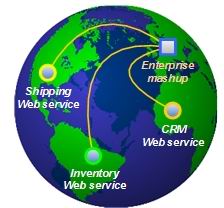Future of Mash Ups
.The group that selects this topic as thiers please put your name and composition here! .Then place your 20 research questions .Then divide the questions amoungst the group and answer them in this page! (to be done for next week Thursday - 4 May)
GROUP MEMBERS
Shanoj Chandroth
Bahadir Odevci
Liz Oldham
Stephanie Veltkamp
INTRODUCTION
Mash-ups of everything imaginable are appearing all over the internet, from blogs and real estate, to social networking and traffic news. Information is now being repurposed in ways never thought possible before. In the course of structuring our approach through the future of mashups, you can find below the questions that we thought of.
"The Web was originally designed to be mashed up," says Google Web developer Aaron Boodman.
UNCERTAINTIES
RESEARCH QUESTIONS AND ANSWERS
What are some examples of mashups?
What are the advantages of mashups?
Why do existing websites let their information be used for mashups?
What are the limiting factors for ubiquitous adoption of mash-ups?
What is SOA, how does it resonate with mash-ups ?
What is SOBA, can SOBA be thought of enterprise mash-up?
What is the future of mash-ups ?
What are the disadvantsges of mashups?
What are the main issues with regards to mashups and copyright law?
Are there any changes being made with regards to mashups and copyright?
How can people learn more about mashups? Mashup camp?
What is Transactional Mashups?
What are the business implications of mashups?
Mashups – Application Exchange Services
Future of Microsoft Business Solution Apps
REFERENCES
http://www.programmableweb.com
http://blogs.zdnet.com/service-oriented/?p=550
http://blogs.zdnet.com/Hinchcliffe/index.php?p=13
http://www.zapthink.com/report.html?id=ZAPFLASH-2006320
http://blogs.zdnet.com/BTL/?p=2517
http://earlystagevc.typepad.com/earlystagevc/2006/02/the_problems_wi.html
Mashups, remix and copyright law, Damien O'Brien and Professor Brian Fitzgerald
DRIVING FORCES
Before we get to the scenarios, let's focus on the underlying reasons for the mashup phenomenon.
Technologists creating for ‘fun’
The desire for software reuse An important driver for mash-ups is the advent of Web 2.0 concepts that encourage software creators to expose their applications as sets of reusable services. The theory is that you can be much more valuable to the rest of the world if your software can be reused in unintended ways. In other words, don't just provide a fully created end-product for one pre-intended use. Encourage others use the good pieces of what you provide in new and innovative ways.
Need for better business software Regarding the enterprise mash-ups, mashups have the potential to deliver zero-footprint, Web-based business applications much faster, cheaper, more reusably, and more maintainable than ever before. Applied correctly, all of this can confer vital competitive advantage.
Ad-hoc demand for services On the demand-side there is a rising comfort with and expectation of finding a throw-away application to do just the one thing you needed when you need it.
Advent of new web client capabilities - Ajax Last year's advent of the web application browser technique, Ajax, has augmented the posibility to mash-up different Web Services on client PCs. Ajax application loads a bunch of Javascript into the browser once and then manipulates the CSS and HTML to provide the visual effect of a full native application. But since it loads once, the Ajax application is cut off from new data that's usually obtained by page reloading. Hence something called XmlHttpRequest, a new addition to browsers that lets Javascript programs in the browser call Web services. Consequently, Ajax appications are mandatory consumers of HTTP services including real, full blown, SOA-type Web services.
Interest on lightweight data protocols There are other driving factors to the mash-ups, like the growing interest in lightweight data formats like JSON, that helps to build online software in little bits and pieces that can be easily wired together (For example the Google Maps Javascript include)
